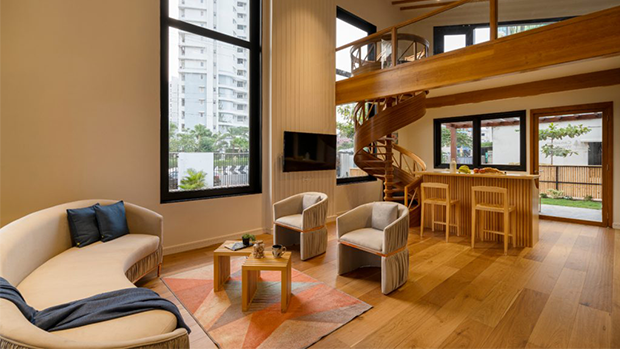A ray of hope in wooden
architecture, a global
phenomenon, comes in the form of
high-quality, high-performance
wood species.
 Wood has outperformed any traditional construction material with the
correct design and construction skills. Furthermore, Wood Frame
Construction is a relatively new concept in India, with the potential for
quick expansion. The market is currently specialized and untapped, but
as timber construction gets more common, it will grow significantly
Wood has outperformed any traditional construction material with the
correct design and construction skills. Furthermore, Wood Frame
Construction is a relatively new concept in India, with the potential for
quick expansion. The market is currently specialized and untapped, but
as timber construction gets more common, it will grow significantly
Canadian Wood has progressively evolved to strengthen its position in
the industrial business, largely to a well-thought-out strategy. It
commenced by exploring the manufacturing industry to discover how
people worked with wood and to gauge consumer preferences.
Builders and architects have made extensive use of wood in their
projects due to its numerous engineering benefits as well as decades of
research and technical breakthroughs.
Woodniidos' projects predominantly emphasis on Canadian wood
species.
Woodniido’s wooden houses are a more environmentally friendly and
cost-effective alternative to classic brick and concrete residences.
Wood is not only a natural product, but it also has environmental
benefits. These wooden houses are constructed from natural, nonpetroleum materials that are both recyclable and biodegradable.
Despite the availability of a wide range of building materials, wood
remains the most widely used construction material in many parts of the
world due to its appealing look, fair cost, ease of working, and
adequate longevity when protected from moisture and insects.
All of Woodniido’s wood products are from licensed Canadian wood
dealers and they mainly deal with 5 different species of wood each
with its own working and physical properties. Canadian wood exhibited
its WoodNiido house, single-story pre-fabricated wood frame house
made from five Canadian wood species. It's one of many
demonstration projects employing Canadian wood species that have
been created across the country. Here are a few of the most common
species we employ in our projects:
1) SPF(Spruce-Pine-Fir):
The spruce-pine-fir (SPF) group is a mix of Engelmann
Spruce, Lodgepole Pine and Subalpine Fir. SPF has a high
strength-to-weight ratio and is primarily used for framing in
North American housing. Due to its dimensional stability and
superior gluing properties, SPF is used extensively in the flatpacked furniture industry. It is also a great choice for
modular houses, interior finishing, boxes, pallets, packaging
cases, and concrete formwork.
But we don’t want to bore you with the technical detail, so
I’ll give you a summary of the key features of all of them
combined, okay?
- Advantages of good planning and shaping quality.
Remember we emphasized versatility?
- It’s got excellent nail and screw holding properties
with very good resistance to splitting.
- Great staining properties.
- Great strength and dimensional stability.
- Outstanding working properties. And that’s our
favorite because it’s such a good experience working
with this material.
- This is where we would normally hand you the
samples, but given we’re WFH in our wood
constructed office, we’re showing you the virtual
samples for reference:

2) Western Hemlock:
Western hemlock features a fine texture and a straight,
uniform grain. This species is seasoned uniformly in dry kilns
to improve its strength and stiffness, and to enhance its
resistance to decay and insect attack. It offers a wide array
of applications, ranging from mouldings and interior
woodworking to general construction, roof decking and
plywood. This wood species is primarily known for its even
grain, which offers excellent machining properties.
3) Douglas Fir:
Douglas fir is valued globally for its extraordinary strength-toweight ratio, making it the ultimate choice for heavy
structural purposes like post and beam construction. It is also
a preferred choice for glue laminated beams (glulam),
doors, general millwork, etc.
4) Yellow Cedar:
Yellow cedar is fine-textured and straight-grained and its
natural extractives make it a decay-resistant wood that is
aromatic when cut. Due to its various natural
characteristics, yellow cedar is widely used for shingles,
poles, marine pilings, oars and paddles, decorative
panelling, mouldings, and cabinet work. The structural
grades of this species are also commonly used for exterior
applications such as bridges, decking, stairs, and for
landscaping.
5) Western Red Cedar:
Western red cedar is one of the most commercially
valuable species. Its exceptional working properties like
natural resistance to termite, rot and decay make it an
ideal choice for outdoor applications. The appealing dark
colour, light weight and soft texture makes it suitable for
various interior applications as well. Its flexibility and
versatility enables its usage in roof shingles, exterior siding,
exterior cladding, decking, greenhouses, and saunas.